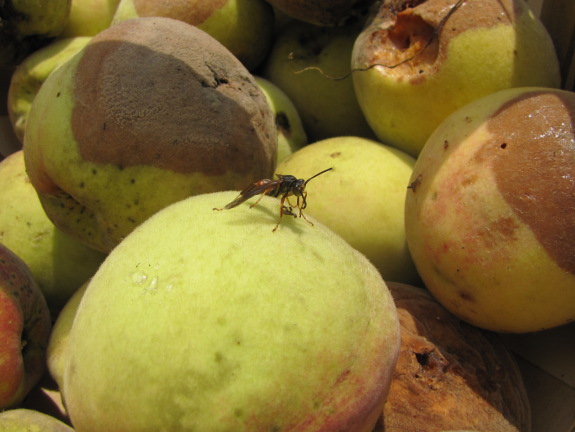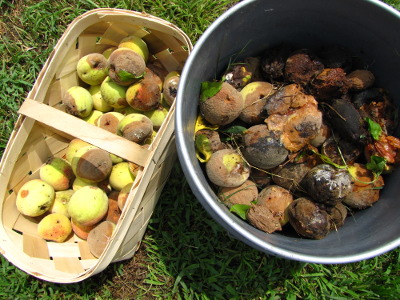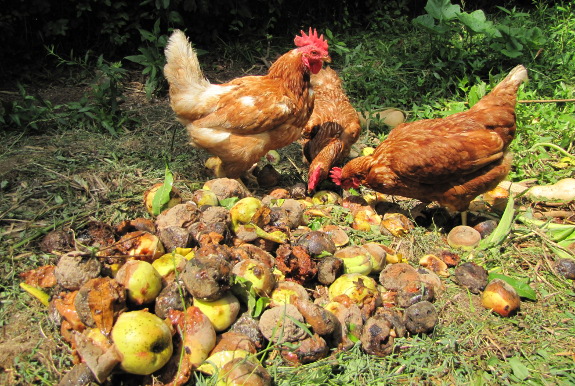
Peach brown rot

This would have been a
bumper year for peaches...if brown rot hadn't hit. Here's what
our extension
service website has
to say about it:
Brown
rot is one of the most destructive diseases of peach and
nectarine in Virginia.... When environmental conditions favor
this
disease, crop loss can be devastating.
 During warm, wet summers, the
fungus that causes brown rot infects stone fruits starting at the
blossom stage, continuing through cankers on twigs, and culminating in
peaches that rot before they fully ripen. We lost every peach
(save one) on our younger peach tree due to endless rain, and even
though I dutifully picked rotting peaches off the kitchen peach every
week, brown rot took nearly the entire crop there too. I ended up
with a five gallon bucket of rotten peaches, about two quarts of
semi-ripe peaches to turn into fruit leather, and just enough ripe
fruits for one dessert.
During warm, wet summers, the
fungus that causes brown rot infects stone fruits starting at the
blossom stage, continuing through cankers on twigs, and culminating in
peaches that rot before they fully ripen. We lost every peach
(save one) on our younger peach tree due to endless rain, and even
though I dutifully picked rotting peaches off the kitchen peach every
week, brown rot took nearly the entire crop there too. I ended up
with a five gallon bucket of rotten peaches, about two quarts of
semi-ripe peaches to turn into fruit leather, and just enough ripe
fruits for one dessert.Since I'm not willing to resort to fungicides, it may turn out that we simply can't ripen peaches during wet years, but there are some tricks I can try to at least lessen future catastrophes.
- Keep the leaves dry. I already prune my peaches to the open center system, which helps the leaves dry off as fast as possible, and I can't do anything about the rain. But I am going to tweak our sprinkler arrangements since they currently hit a little bit of our peach trees when I water the garden.
- Sanitation. The
fungus overwinters in so-called mummies --- dried up fruit that sit on
the tree or on the ground. I do my best to remove all bad fruits,
but I think I'm going to find a way to turn chickens under our peaches
for a little while right after harvest to catch anything I miss.
- Work harder to prevent insect
damage. Unripe peaches are usually safe from brown rot,
but not if their protective skin has been damaged by insects. Oriental
fruit moth larvae were a huge problem in our peaches last year, and
even though I clipped off injured twigs and thinned out infested
fruits, some still got past my radar. (I'd say my sanitation
practices reduced the insect damage by about 75%.) I'm hoping
that mini chicken pastures will help with this problem as well since
the moths overwinter in debris on the ground and chickens love looking
for insects under mulch.
- Remove the most susceptible trees. Nectarines tend to be more prone to brown rot than peaches are, and in retrospect, that's probably why our nectarine --- covered with flowers this past spring --- set no fruit. The dwarf cherry that set twelve fruits and then had them all rot before ripening also did its part to let the fungus keep reproducing all spring. Neither of these trees is happy here, so I'm going to finally rip them out so that they can't serve as reservoirs of disease that will later infect my good trees.
- Give my fruit trees less compost.
One study suggests that too much nitrogen can make trees more prone to
infection by brown rot. Perhaps I need to back off on the compost?

Want more in-depth information? Browse through our books.
Or explore more posts by date or by subject.
About us: Anna Hess and Mark Hamilton spent over a decade living self-sufficiently in the mountains of Virginia before moving north to start over from scratch in the foothills of Ohio. They've experimented with permaculture, no-till gardening, trailersteading, home-based microbusinesses and much more, writing about their adventures in both blogs and books.
Want to be notified when new comments are posted on this page? Click on the RSS button after you add a comment to subscribe to the comment feed, or simply check the box beside "email replies to me" while writing your comment.

Sorry to hear about your peaches. If it's any consultation, our neighbor has several varieties of peaches and sprayed ALOT of fungicides....to no avail. This last crop that is coming on may have avoided it. His early varieties rotted or simply failed to pollinate even with the bee boxes in the area. it's been a lovely cool summer for people...not so much for the vegetables and fruits
Zimmy --- That's a good question, and I wasn't really talking about home remedies like that so much as the heavier duty anti-fungals that people use against brown rot. However, I've noticed that even the most benign-seeming chemicals used in the garden tend to act as a bandaid rather than a cure, and I'd rather get to the root of the problem. Our dabbling in using Bt to combat the vine borer is a good example --- we were killing off a lot of other insects and it didn't seem to do much good against the borer compared to the cultural practices I ended up choosing (stick to more resistant varieties and use succession planting.)
I'm at least partly of the belief that when insects or diseases hit a crop plant, they're an indicator of previous ill health of the plant due to something we did wrong. I've noticed that the beans most hit by bean beetles this year are in the beds I overfertilized, for example. By tweaking my growing conditions, I should eventually be able to deal with most diseases without chemicals. (I hope!)
If you are set on removing the nectarines and the cherries may I suggest that you try removing a few large branches and grafting on to them? With time you could completely replace the cultivar and it gives you an opportunity to experiment with grafting. Even if the grafts fail, you would have removed those trees anyway and nothing is lost, other than time and you gain a new experience. (full disclosure: part of the reason I want you to do this is that I am interested in doing it myself and want to see how it turns out :P )
Good suggestion! There are a few things to consider if you're grafting onto problematic trees.
First, I don't think it's worthwhile at all for our cherry. If you have a troubled tree and you think the problem is the tree variety itself, you have to consider further --- is it the roostock or is it the scionwood? For the cherry, I'm pretty sure the problem is the dwarfing rootstock --- some people seem to have luck with dwarf trees, but mine always seem to fail. Since grafting new scionwood onto the tree would keep the same rootstock, there's no point in regrafting the cherry.
I'd be tempted to try grafting a new peach variety onto the nectarine, but I'm afraid the tree has aged past the point where it would be easy to get rid of the current nectarine variety. Despite all of its ailments, the nectarine has some pretty big branches, and if I left any of them in place, they'd continue to be a reservoir for infecting the rest of the orchard. Plus, I'd be making a three-part tree --- rootstock, nectarine interstem, and then something else scionwood. It's hard to say what the nectarine interstem would do to the scionwood.
What I might do is cut the nectarine to the ground so that I go back all the way to the rootstock (which is presumably not a problem here.) Then, if the rootstock sends up sprouts next year, the way they often do, I'll try grafting onto that. Hmmm...sounds like a fun experiment. Thanks for the suggestion!